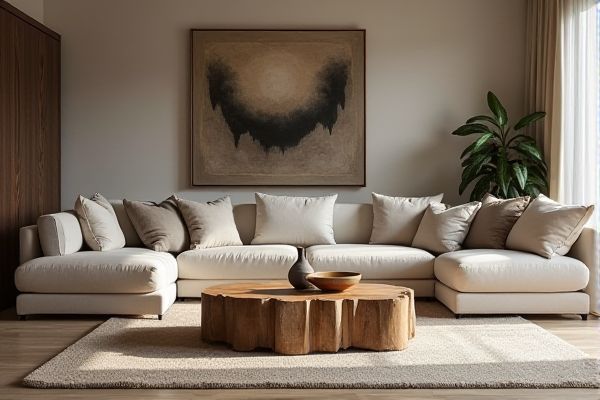
Coffee tables are typically lower and larger, designed to sit in front of a sofa for casual use, while cocktail tables, often more elegant and decorative, serve as focal points in entertaining spaces. Discover how choosing the right table can enhance Your living area by exploring the detailed differences in the rest of this article.
Table of Comparison
| Feature | Coffee Table | Cocktail Table |
|---|---|---|
| Purpose | Centerpiece for living room, holds books, drinks, snacks | Small side table, primarily for serving cocktails and drinks |
| Size | Larger, typically 36-48 inches long | Smaller, usually 18-24 inches in diameter |
| Height | Lower, around 16-18 inches high | Higher, generally 22-30 inches tall |
| Shape | Varied: rectangular, oval, round, square | Mostly round or small square |
| Placement | Positioned in front of a sofa or seating area | Placed beside chairs or sofas for easy access to drinks |
| Materials | Wood, glass, metal, or mixed materials | Often glass or wood, designed for elegance and convenience |
Coffee Table vs Cocktail Table: Key Differences
A coffee table typically features a lower height and larger surface area meant for casual use in living rooms, while a cocktail table is slightly taller and designed primarily for serving drinks at gatherings. Coffee tables often showcase multifunctional designs with storage options, whereas cocktail tables emphasize style and elegance suitable for entertaining. Understanding these key differences helps you select the ideal table that complements your space and lifestyle.
Design and Style Variations
Coffee tables offer versatile design and style variations ranging from minimalist modern pieces to rustic wooden options, enhancing casual living spaces with functionality and comfort. Cocktail tables tend to showcase more elegant and sophisticated designs, often featuring glass tops, metallic accents, or intricate detailing that elevate a room's ambiance for entertaining guests. Your choice between these tables should reflect your interior aesthetic and how you intend to use the piece, whether for everyday convenience or stylish social gatherings.
Historical Origins of Coffee Tables and Cocktail Tables
Coffee tables originated in the 17th century as low tables placed in front of sofas for serving coffee and displaying decorative items, reflecting European social customs. Cocktail tables emerged in the early 20th century, designed specifically for cocktail parties to hold drinks and appetizers, emphasizing functional entertainment space. Understanding these historical origins helps you choose a table that fits your living room's style and purpose.
Typical Sizes and Shapes Compared
Coffee tables typically measure between 36 to 48 inches in length, with widths around 18 to 24 inches, and heights ranging from 16 to 18 inches, often featuring rectangular or oval shapes designed to complement sofas. Cocktail tables share similar heights but tend to be larger in diameter, usually round or square, with diameters or sides measuring between 30 to 48 inches to accommodate more surface area for drinks and social use. The choice between the two depends on room size and seating arrangement, where coffee tables prioritize accessibility and cocktail tables offer versatile, communal spaces.
Functional Uses in Modern Living Rooms
Coffee tables serve as versatile surfaces for everyday activities such as holding drinks, books, and remote controls, enhancing the functionality of modern living rooms. Cocktail tables often prioritize style and social interaction, providing a more refined surface for serving beverages and snacks during gatherings. Both table types contribute to living room organization but cater to different user needs: coffee tables focusing on practicality, while cocktail tables emphasize elegant entertaining.
Materials: Wood, Glass, and More
Coffee tables often feature wood constructions, providing warmth and durability, while cocktail tables commonly incorporate glass tops for a sleek, modern aesthetic. Both styles utilize metal frames and composite materials to enhance stability and design diversity. The choice between wood or glass depends on desired ambiance and maintenance preferences in living spaces.
Placement and Room Configuration Tips
Coffee tables typically suit casual living room layouts, placed centrally in front of a sofa to facilitate easy access and conversation. Cocktail tables are often positioned in more formal seating areas or lounges, offering a stylish focal point that complements arrangement symmetry. You can optimize room flow and interaction by considering table size relative to seating distance, ensuring comfortable movement around furniture.
Matching Tables to Decor Styles
Coffee tables typically complement casual or contemporary decor with their lower height and versatile designs, making them ideal for living rooms featuring sofas and lounge chairs. Cocktail tables often suit more formal or traditional settings due to their larger surface area and elegant finishes, enhancing spaces such as sitting rooms or entertainment areas. Selecting between a coffee table and a cocktail table depends on the room's existing style, furniture arrangement, and the desired ambiance.
Maintenance and Durability Considerations
Coffee tables typically feature a sturdier design with durable materials like solid wood or metal, making them easier to maintain and resistant to daily wear and tear. Cocktail tables often have glass tops and intricate detailing that require delicate cleaning and careful handling to avoid scratches and damage. When selecting between the two, consider the frequency of use and the environment, as coffee tables generally offer greater longevity and lower maintenance needs compared to cocktail tables.
Choosing the Right Table for Your Space
Selecting the perfect table for your space depends on its intended use and style; coffee tables typically sit lower and cater to casual lounging areas, while cocktail tables are slightly taller and designed for entertaining guests. Opt for a coffee table when you need a functional centerpiece for placing books, remotes, or snacks in a living room setting. Choose a cocktail table to create an elegant, social atmosphere that accommodates drinks and small plates in more formal or party-centric environments.
 homyna.com
homyna.com